This homemade deodorant stick is a simple recipe that actually works! Using DIY deodorant is a great way to support your health, reduce waste and chemicals, and smell good!
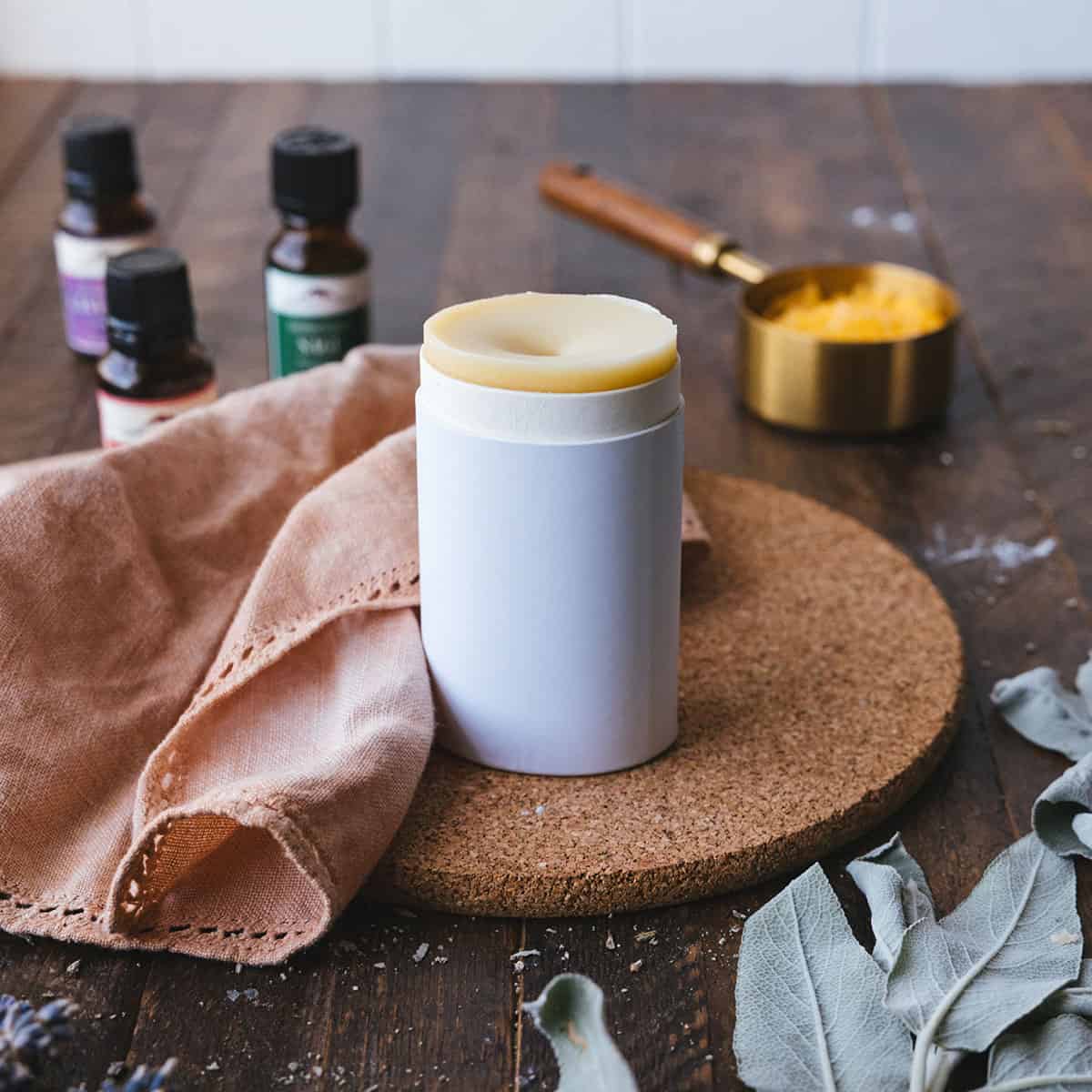
Want to save this post for later?
When I first began delving into making herbal bath and beauty products myself many years ago, it all started with homemade herbal deodorant. It’s the perfect beginner recipe for DIY beauty products.
This recipe is simple to make, is good for your health and the environment. The best part is that this homemade deodorant recipe really works!
Why Make Your Own Deodorant?
You might wonder why you’d want to make your own deodorant when there are so many on the market to choose from. First of all, in my experience, none of the natural deodorants sold in stores work very well and they’re ridiculously expensive.
They might smell good going on, but give it a day’s work, a stressful meeting, or your daily workout, and you might as well not wear deodorant at all. That’s just not my jam!
Then, regular store bought deodorant is full very questionable ingredients, to say the least. If you haven’t looked at the ingredient list, I suggest checking it out. I don’t know what half of it even is!
I know you’re not eating it, but all those chemicals can get into your body through your skin. One of the main benefits of DIY beauty products is that you have control over exactly what is going into it.
Plus, homemade deodorant is so much easier on the environment. It reduces plastic container waste, and any other production waste too.
I prefer to use the cardboard containers shown in the photos, but silicone molds work just as well.
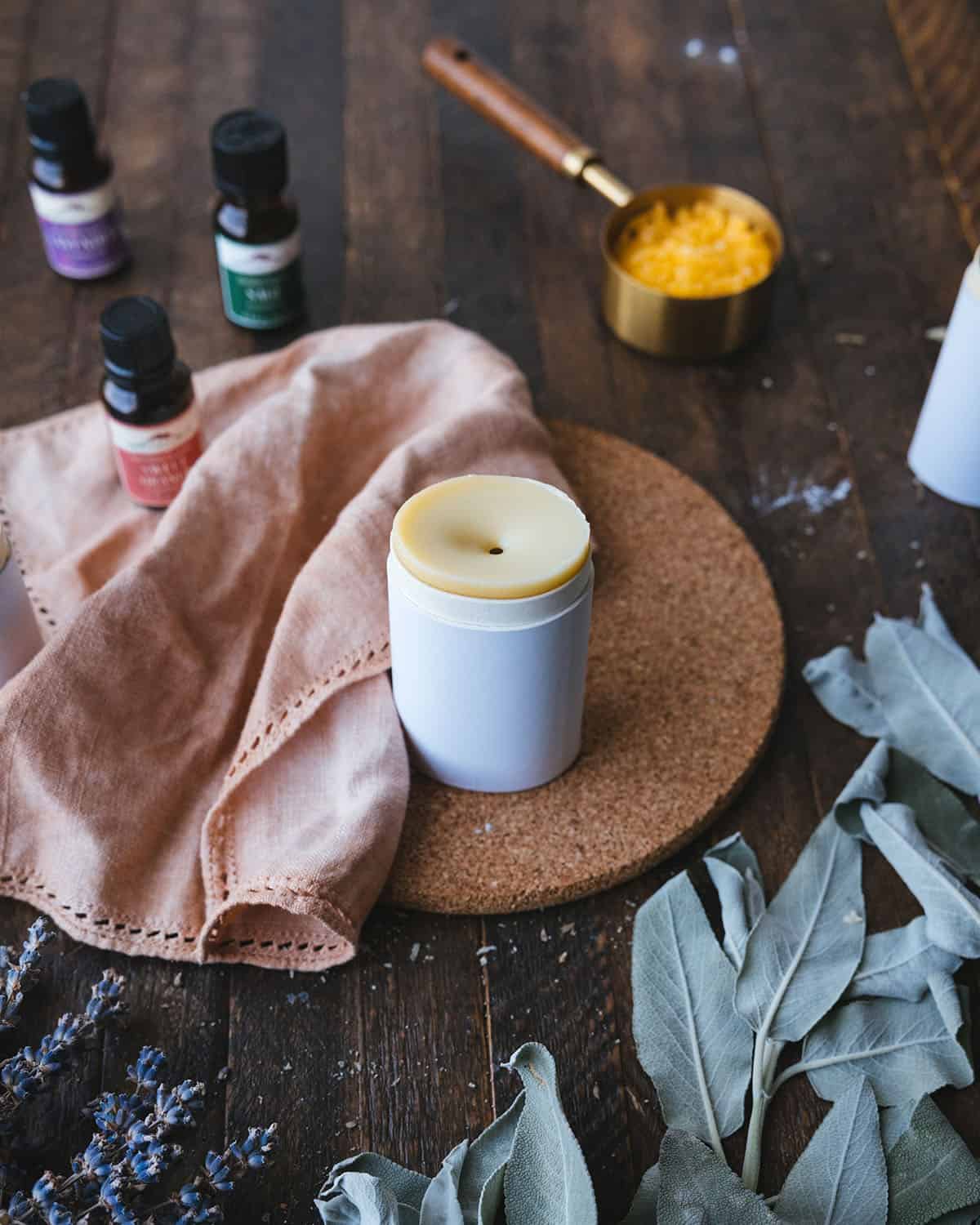
What Goes in Homemade Deodorant?
Homemade deodorant is a common recipe, generally using coconut oil, baking soda, arrowroot or cornstarch, and essential oils. It works well as deodorant, but is too soft for a mold or tube, and melts in warm weather making it unusable.
This is why I created a homemade deodorant recipe that is a little bit different. Using beeswax and shea butter creates a thicker consistency that will hold up in a deodorant container or a mold.
This makes applying it much easier no matter the weather! Plus, you get the benefits of a natural deodorant stick, and your fingers don’t get messy applying it either way.
Ingredients
Beeswax is beneficial in homemade deodorant recipes because it’s naturally antiseptic, antibacterial, emollient, and hydrating to the skin.
Shea butter is odorless (if you used refined), moisturizing, and works to help with a perfect natural deodorant stick consistency.
Substitute: It works to use carnauba wax instead of beeswax, if preferred. Use less than called for, as it’s a harder wax.
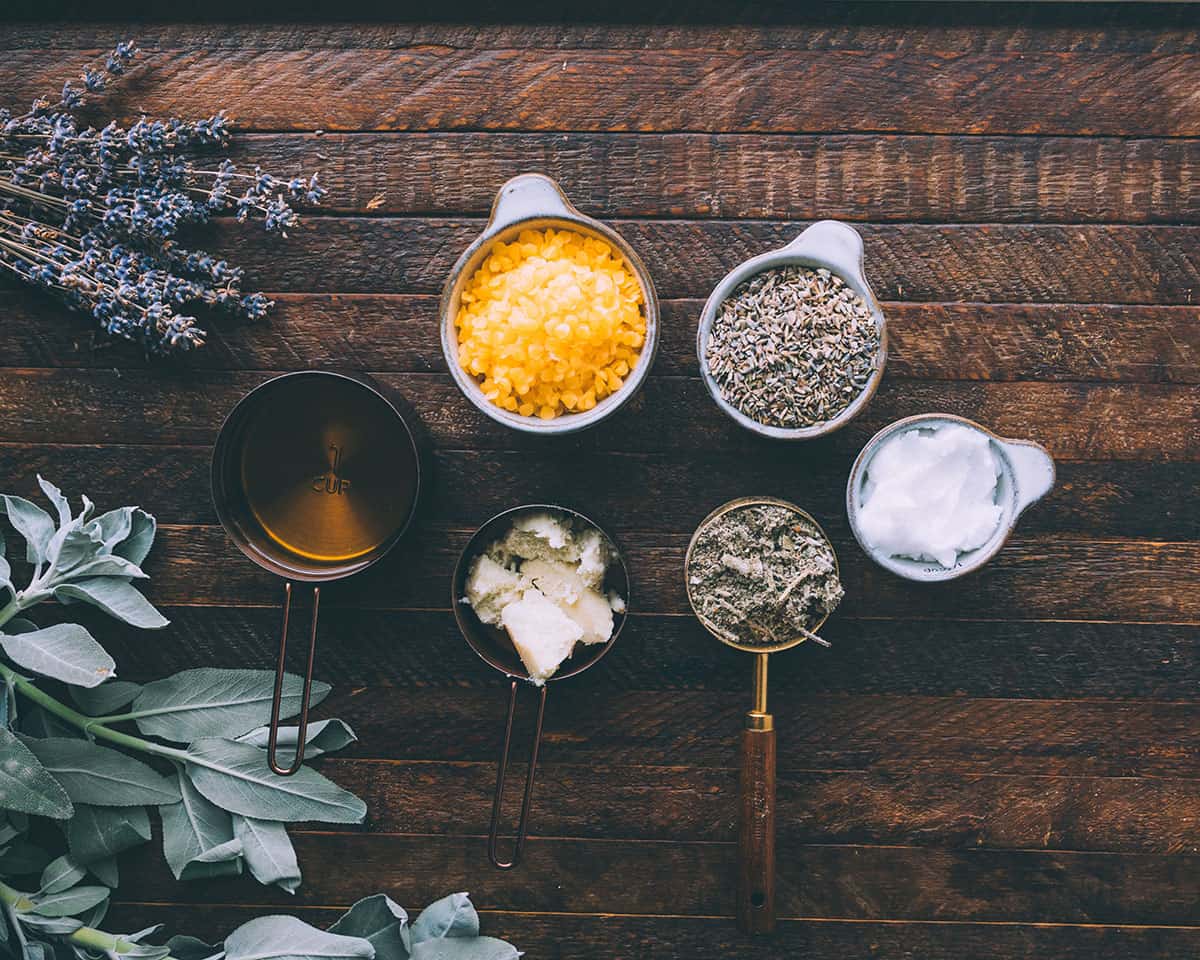
Baking soda and arrowroot powder work perfectly for their natural deodorizing effect. If you are sensitive to baking soda, it’s okay to omit it and replace with more arrowroot powder.
Essential oils make the deodorant smell good while also adding some antimicrobial, antibacterial, and anti-fungal properties.
Infused oil: An herbal infused blend of coconut oil and sweet almond oil works best for this deodorant recipe. Coconut oil is antimicrobial and anti-fungal, and sweet almond oil is light and absorbs easily into the skin, leaving minimal oil residue left after application.
Dried lavender and sage are the best choices for making herbal deodorant.
Note: Lavender is wonderful for skin care products due to germ fighting benefits and its beautifully calming scent. Sage is perfect because it has some natural antiperspirant properties.
There are many other herbs you could choose depending on your preferences. Some good options are rosemary, mint, calendula, oregano, marshmallow root, yarrow, rose, chamomile, and lemon balm.
My favorite place to get high quality, organic dried herbs is Mountain Rose Herbs.
Homemade Deodorant Recipe with Lavender and Sage
The first step in this recipe is to make an infused herbal oil with lavender and sage, or any other herbs of your choice.
For the Infused Herbal Oil
First, place the dried lavender and sage, or other herbs of your choice in a pint mason jar.
Then, melt the coconut oil over low heat. This should only take a few minutes.
Pour the melted coconut oil into the jar over the herbs, and then fill the jar up the rest of the way with sweet almond oil.
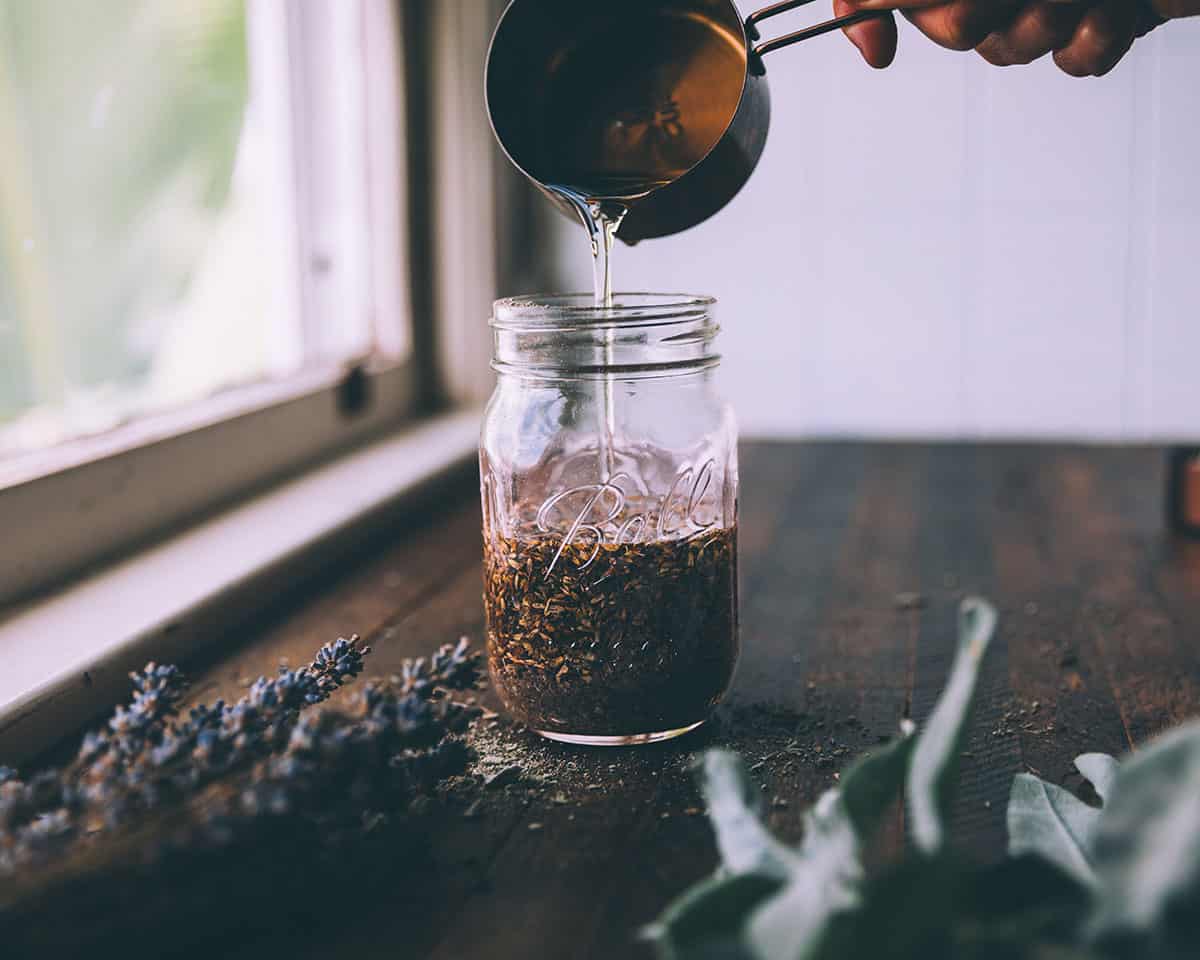
Now, cover the jar and put it in a cool and dark place like a pantry or a kitchen corner without sunlight. Let it infuse for 1-2 weeks.
Once infused, strain the spent herbs out with a fine mesh sieve. Now it is ready to use in homemade deodorant!
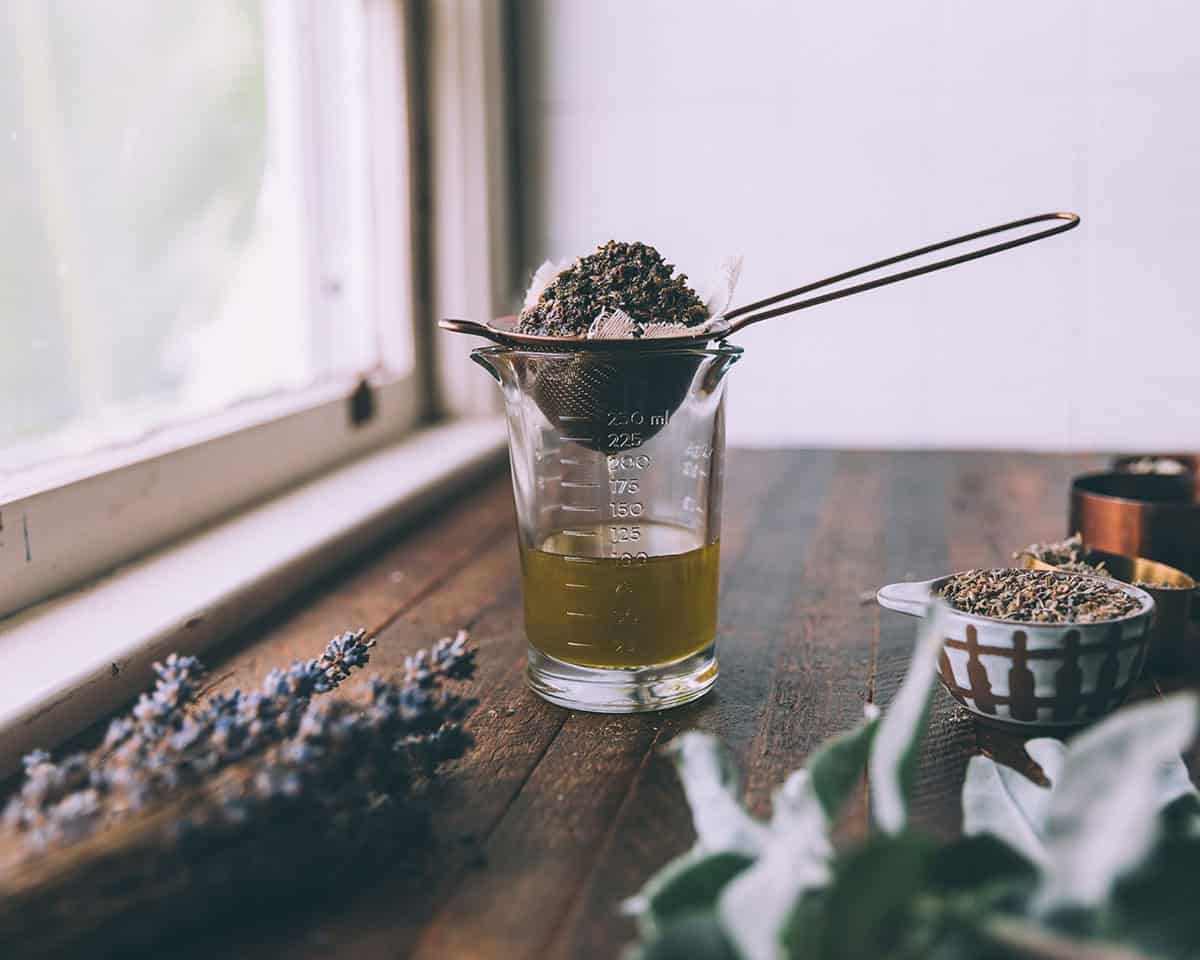
Make the Deodorant
Now that the infused oil is ready, put it and the beeswax into the top container of a double boiler. Stir continuously as the beeswax melts.
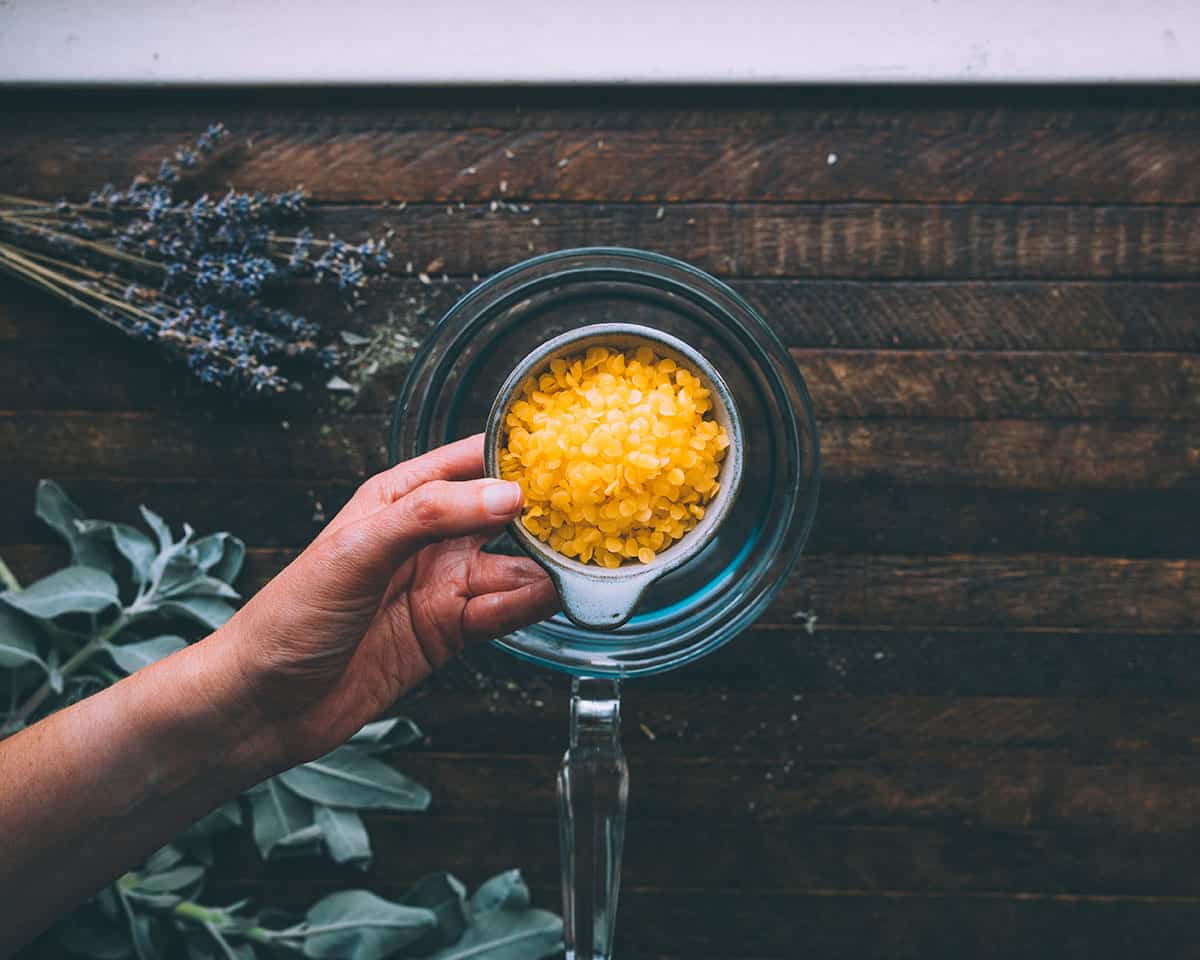
Note: You can use a makeshift double boiler using a smaller pot, bowl, or a glass Pyrex measuring cup over an inch or so of water simmering in a pot.
Once the beeswax has completely melted, add the shea butter and stir until it dissolves.
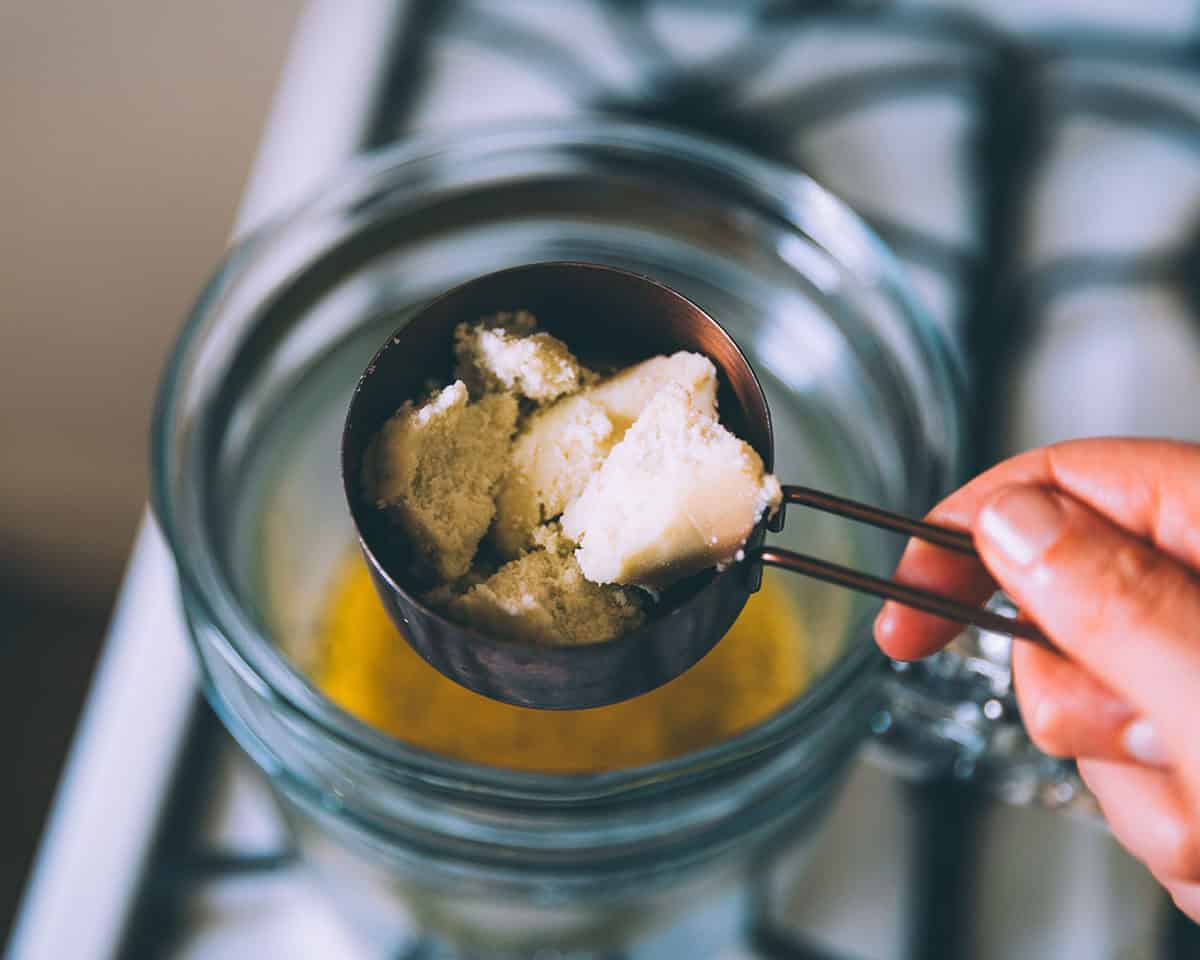
Remove the mixture from the double boiler and stir in the essential oils, then stir in the arrowroot powder and baking soda.
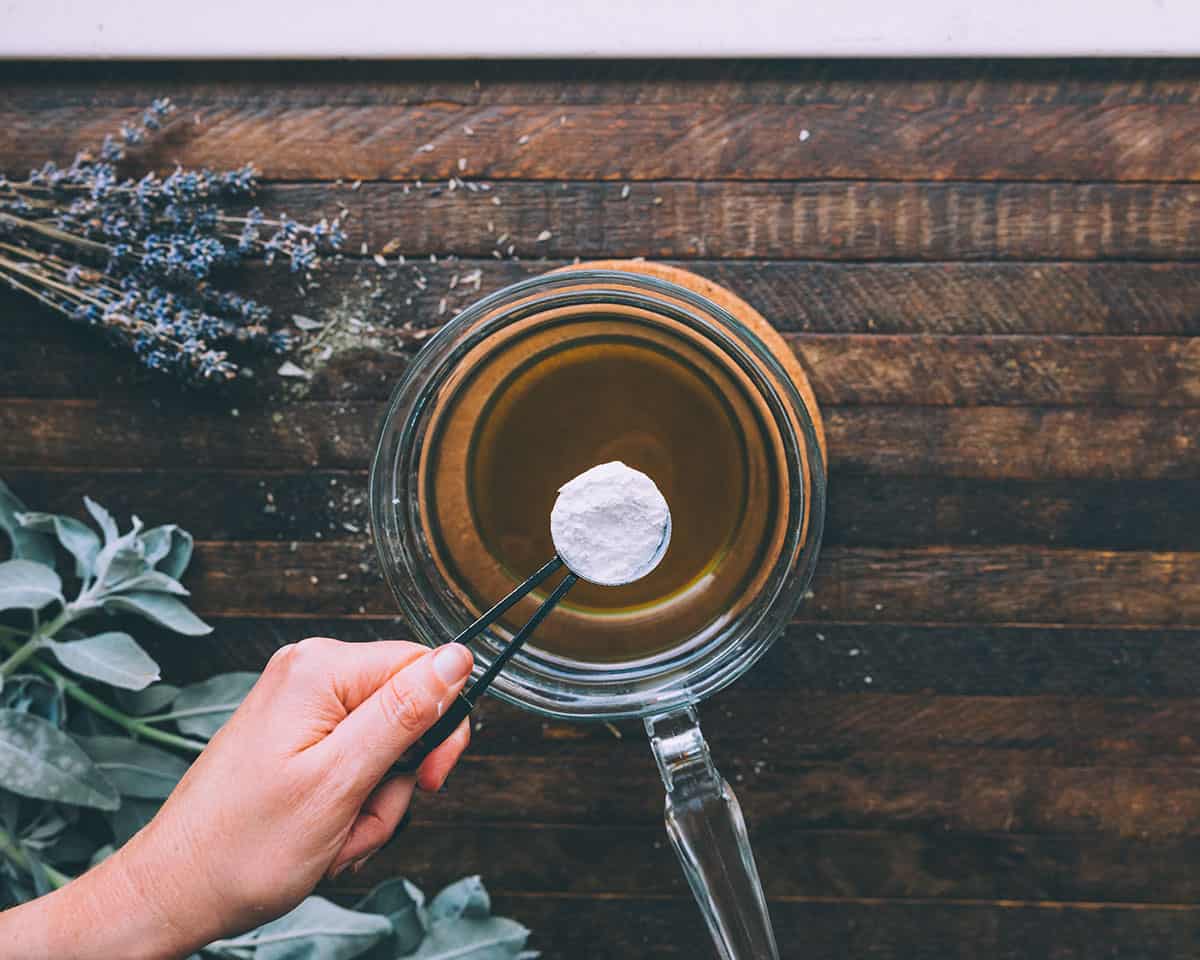
Keep stirring for a minute or two to thoroughly combine. The mixture will begin to thicken slightly.
Pour the mixture into empty deodorant containers or half circle silicone molds.
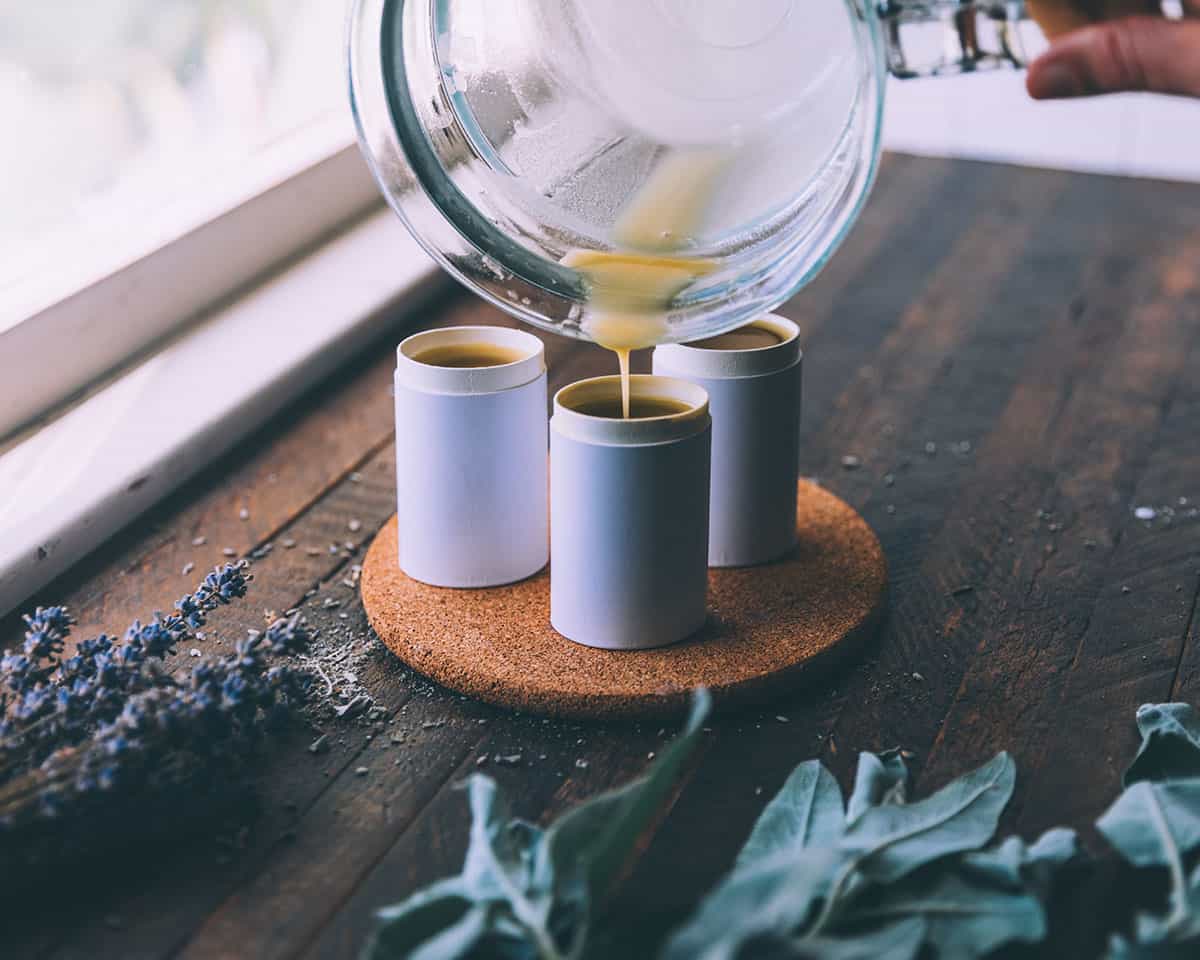
Let the deodorant set up for a few hours until it is solidly formed before using.
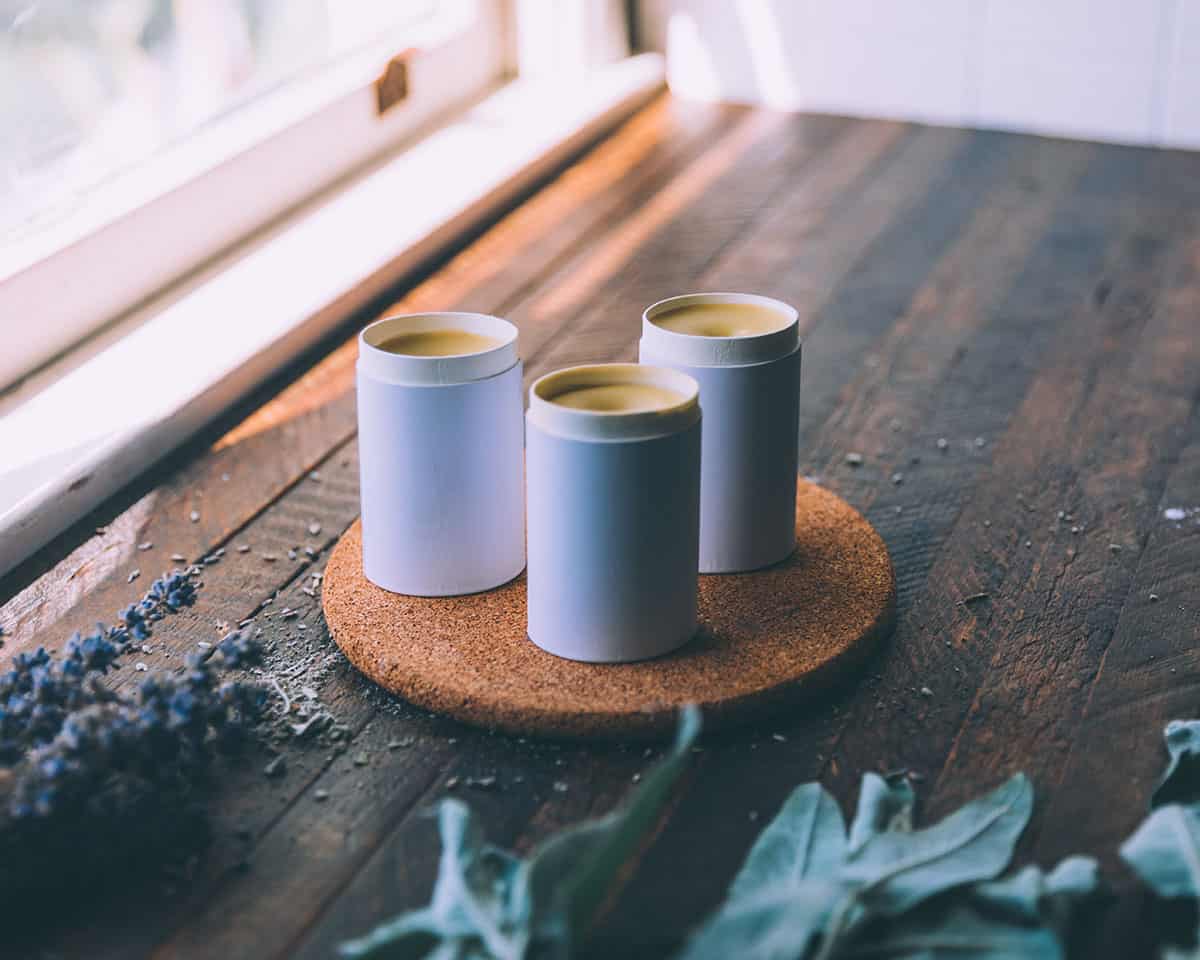
Using Herbal DIY Deodorant
Use your herbal homemade deodorant just as you would any other deodorant, it’s that easy. It’s amazing how well this deodorant works, the lavender and sage combination are highly effective and smell good.
Even if you’ve had trouble with homemade deodorants in the past, I recommend you try this one. It is absolutely the best natural deodorant, and I’m so happy to be ditching the store bought stuff for good!
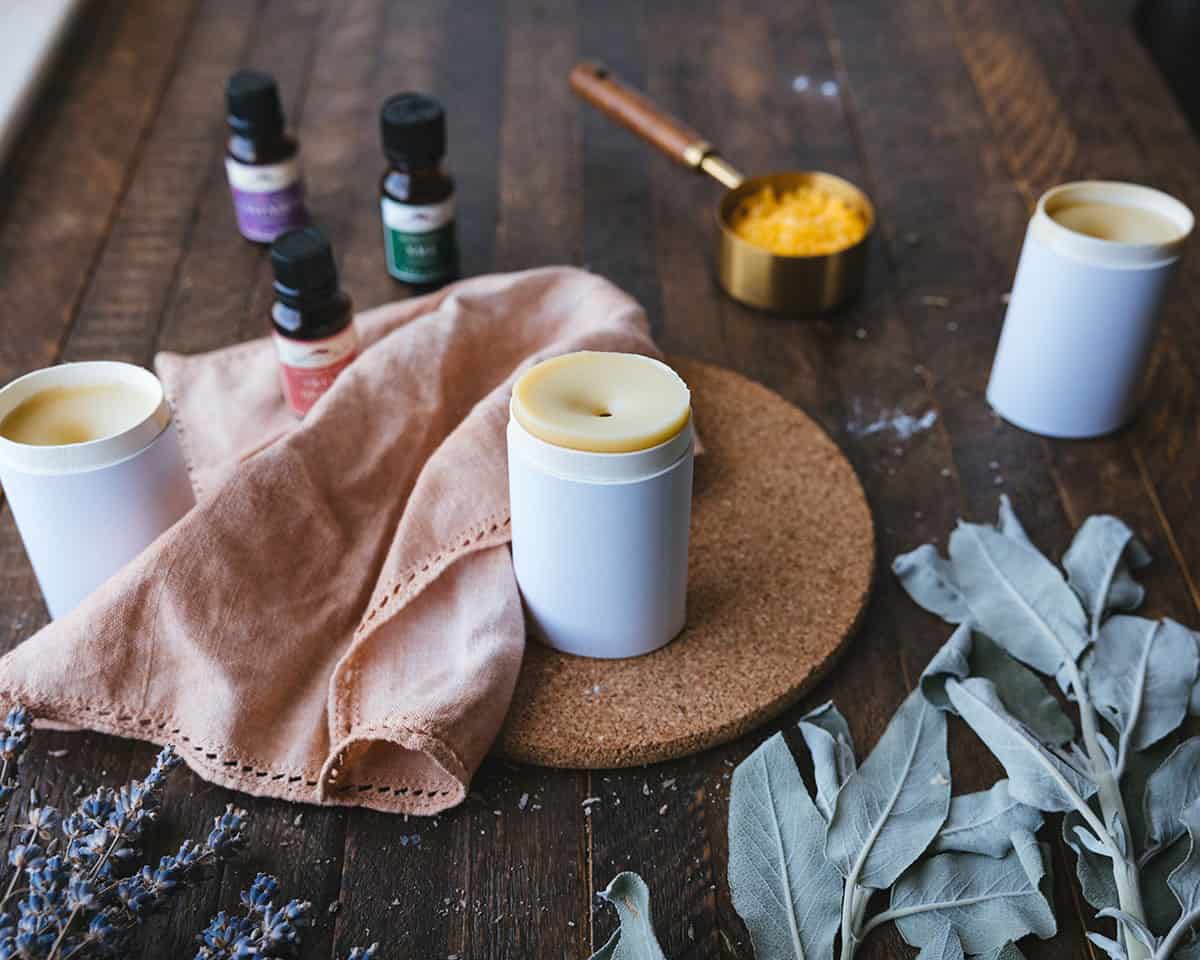
Keep in mind that if you are new to natural deodorant without antiperspirant, many people notice increased sweating as their body adjusts. Don’t worry though, it will balance out over time.
Once you make the switch to this homemade deodorant, you, your budget, and the earth will be healthier for it!
More DIY Body Care
- Lavender Salve
- Calendula Lip Balm
- Rosemary Pine Beard Balm
- Rosemary Mint Shampoo Bars
- Rose Lotion Bars
- Rose Hip Facial Oil
Homemade Deodorant with Sage and Lavender
Equipment
Ingredients
Infused Herbal Oil
- 1/3 cup dried sage leaves
- 1/3 cup dried lavender
- 1/4 cup coconut oil
- 3/4 cup sweet almond oil (approximately)
Homemade Deodorant
- 1/2 cup infused herbal oil
- 2 ounces beeswax
- 1 ounce shea butter
- 20-30 drops essential oil I like to use 10 drops each of lavender, sage, and sweet orange
- 2 tablespoons arrowroot powder
- 2 teaspoons baking soda optional or substitute with more arrowroot powder
Instructions
Infused Herbal Oil
- Place the herbs in a half pint mason jar.
- Melt the coconut oil over low heat.
- Add the coconut oil to the jar of herbs and then fill the jar the rest of the way with sweet almond oil.
- Cover the jar and put in a cool and dark place to infuse for 1-2 weeks.
- Strain out the herbal material with a fine mesh sieve when ready to use.
Homemade Deodorant
- Put the infused oil and beeswax into the top container of a double boiler, and stir as the beeswax melts. You can create a makeshift double boiler by putting a small bowl or a glass Pyrex measuring cup over a pot with about an inch of simmering water.
- Once the beeswax has completely melted, add the shea butter and stir until it dissolves.
- Remove the mixture from the double boiler and stir in the essential oils, then stir in the arrowroot powder and baking soda. Keep stirring for a minute or two to thoroughly combine. The mixture will begin to thicken slightly.
- Pour the mixture into empty deodorant containers. Let the deodorant set up for a few hours before using.
Notes

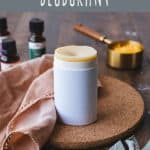

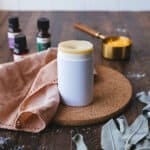

Hey! I’m really excited to try this as I have most if not all the ingredients. I have a couple questions tho.. Temps in Utah have dropped and my house is really cold. My coconut oil is rock hard and I’m not sure if it will infuse very well. I’ll still try warming it first and see how it goes but if I did want to speed up the infusion process with a double boiler, how long would I need to do it for?
And also I love shea butter but I always smell it in my homemade products. I have mango butter. Would that be a good swap?
When using the double boiler method or infusing herbs in oil, you’ll want to heat them for around 30 minutes or so. Sure, you can definitely use mango butter if you prefer!
How would you add cucumber and mint?
I’m not sure about cucumber, but you could add a few drops of mint essential oil.
Great, thanks!
I’ve tried homemade deodorants in the past. They all have left grease marks on my clothes. How do you keep it from staining? I’d really like to make my own, but have never had success because of the oils. I can’t really go around with no shirt until it soaks in. :D
I haven’t really had that problem, but you could try applying it after your shirt is on.
I really wanted to love this recipe but mine also left stains under my armpit :( I see a crust on the inside of the clothes around the armpit almost like beeswax hardened in a layer) and then some oil will soak through the shirt too. I’m not sure what could be done to fix this.
There’s not much that can be done about this, unfortunately. This is the nature of all natural deodorants, including store-bought.
Hi!
Eager to try this. I’ve read really good things about using magnesium in deodorants. Have you ever tried this? If so, how much would you recommend adding to the recipe?
I haven’t tried. I’d start with a little bit just to make sure I didn’t have a reaction to it and increase if needed.
I’m so pumped to try this out. After ordering some of the things I didn’t have, I thought I was set to go. However, I realized I don’t have a mold 🤦♀️ so. Being that it was just Easter, we have a millionty plastic eggs of various sizes and I’m wondering if that would do the job? If I did that, should I try oiling the inside to increase my chances of it coming out easily? What are your thoughts? Thanks!
That’s a creative idea! You shouldn’t need to pre-oil the inside. If it seems tight at all getting it out, I would let it sit in a warm area, not for long, until it softens enough that you’re able to remove it. Give it a try and let me know how it goes!
Hello,
I’m interested in making this recipe but I’m curious, can I skip the oil infusion and just use plain cocounut oil? Would the recipe come out the same? Thank you!
Hi Allison. Yes, that’s totally fine!
hi, i was considering making this, it sounds simple enough and i have all the ingredients on hand which is rare however i’m a little confused, is it to be used like a balm, so wiping some on fingertips then on the under arms or do you wipe the whole bar on your under your arms??
I wipe with the whole bar, the same as you do with a bar of deodorant.
I read all the wonderful reviews before asking ,
Is there an alternative cruelty free option for the beeswax?
This looks like a really nice recipe that I would try after I use all the Lume product that I’ve been using, which I like but I also like to INCORPORATE homemade when possible to cut down on plastic use
Thank you 😊
You can use any vegan beeswax alternative on the market.
After having made this recipe several times, I would say this is the best I have found. There are many things on this site that are better than most. I live in South Texas where the summers can get 115 degrees without hesitation. This deodorant does not melt in my house (even with air conditioning it still gets warm during the day). I do, however, add a bit more beeswax just because of the heat.
I’m so happy you like this recipe, Adrienne!
Hi, how many half circles will this recipe yield? Thank you for your recipe and reply 😊
Hi Claudia. This recipe produces 8 ounces. My mold held 1 ounce each, so 8 total. It’s really dependant on the size of your mold.
Would keeping them in a 2oz tin work well for rolling them on if I use the 1oz molds?
Thanks!
Maybe, but I’d be concerned with a 1 oz. bar melting, if it’s warm where you live.
Hello
For the infused oil, can I put the oil and dried leaves and lavender in a mason jar and boil it for a couple of hours to infuse the oil
Hi Vickie. It’s best not to boil infused oils, you certainly can slowly heat your oil in a double boiler to speed up the extraction.
If I didn’t want to infuse the oil with herbs would I just add the same amount of coconut and almond oil to the beeswax? Would I still get the same effect without the herb infused oil?
Hi Candice. Yes, if you want to forgo infusing the oil, that’s totally fine.
I don’t have a scale. How many Tbsp is an ounce of Shea butter? And how do I get the nice green color in the picture?
Roughly 1.5 -2 tablespoons. The finished product is light yellow that’s dependent on the color of your beeswax. A lot of beeswaxes are a shade of yellow, but you can typically find white if you prefer.
Can I substitute the Shea butter for cocoa butter? Would that effect it in anyway? Thanks
Nope. That’s totally fine, Amanda!
Hi there! I was wondering, with this recipe would this deodorant expired after a certain time or could it be made and stored for long term storage (5-10 years?). Thanks!
Hi Meghann. That’s a really good question and one I’m not sure how to answer. Coconut oil has a shelf life of 2 years before it becomes rancid. I imagine if your deodorant is refrigerated or kept in a cool environment, you could extend its life beyond those 2 years.
Hi I just wanted to report, I have 8 year old coconut oil & it’s still smells great and I’m using it now!
Awesome. Enjoy!
Hello! I was wondering if it’s possible to use the “quick method” (by heating the oil and dried flowers in a pot on low heat for some hours.) in this recipe?
Yes, you can do that.
Hi,
It isn’t clear if all the herbs are dried, or fresh. I would like to use sage and rosemary. Do they need to be dried.
Yes, both of your herbs should be dried so that they don’t leach any moisture into your infused oil.
Curious if the sage leaf & dried lavender are washed after harvest? Hoping it doesn’t matter.
Hi, Dana. It doesn’t really matter, but you could rinse it if it needs it.
Hey I want to try that. I love diy balms and such
Sarah, I mixed jasmine, lavender, and lemon grass and also took the advice to add extra baking soda (1 teaspoon extra). I too struggle with severe body odor sometimes. So far this combination seems to be working. Smells good to me too.
Thanks so much for the recipe.I’m a newbie to diy soaps and balms. Any tips on anything is very helpful to me.
You’re welcome.
Hello! I’d be much obliged if you clarified whether the Oz. are fluid or by weight??
I’m in Canada and I’m confused lol!
Thank you!
Hi Julia. Sorry for the confusion! The measurements are by weight.
Hello colleen! I would like to make this recipe for my daughter, but she is allergic to anything coconut. I often switch out avacado oil for coconut oil in salve recipes, but I’m wondering if I would need to add more beeswax to help with the consistency of the deodorant. I’m concerned that it would end up being too soft. Any suggestions?? Thanks so much 😄
Hi, Anne! You could try upping the beeswax in the recipe. Another alternative is tallow. Tallow is super nourishing for the skin and stays solid at room temperature.
Thanks!!!!
questions about the herbal-infused oil: in the past, when i’ve attempted to infuse coconut oil and mixed it with a non-solid oil ( usually grapeseed), it STILL firms up 1)are the herbs still infusing even though it’s solid? 2) should i be using a different oil rather than grapeseed?
CHEERS
I typically use high quality, light olive oil as my carrier oil of choice, but there’s nothing wrong with using grapeseed. I prefer to make a blend of olive, sweet almond, and coconut oil (like I did in this recipe for calendula salve) and it doesn’t firm up too much. If it does, however, I may set in a sunny window for a bit to remelt the oils.
This sounds lovely! I can’t wait to try it out- thanks :)
You’re welcome, Beth!
For people who need something stronger for really stinky type sweat: try tea tree oil. It’s the only natural ingredient I have found that works for me.
Sadly this did not work for me, I absolutely stink of sweat lol 😩! Can I melt the mixture and try to add something…suggestions please? Thanks
Hi Sarah, sorry this didn’t work for you! It is still my favorite deodorant. Did you use the baking soda and/or arrowroot powder? You could try adding a little more of those to help deodorize, but go easy on the baking soda as it can cause skin reactions in some people. There are also some natural clays that can be added to help absorb odors. Also, if you do melt it down again, it may have a grainier texture once it rehardens, but it should still be usable.
Hello.I would like to ask if olive oil can be used in making herbal oil? And what is the difference between olive oil and almond and coconut oil? Thank you!
Yes, I frequently use olive oil in my herbal products. It’s just my preference to use coconut and almond oil, but you could totally use only olive oil if you’d like.
Hi Sarah, ive had that issue as well. Our body is speaking to us. It is trying to get rid of toxins in the body. Take a week to do green juices once per day, increase your water intake (half your body weight in ounces is your ideal water intake – sip your water throughout the day not gulp it down), take charcoal water once per day to mop up toxins in the body (must be done with increased water intake ) – eat more fiber rich foods such as increasing your portion of fresh fruits and veggies in your meals. You can also do a mild liver detox by smearing oil on a paper towel, placing it over the liver area and placing a hot water bottle over it or a heating pad. Keep it one for 20 mins.
In addition to those things I do a mixture of fresh lemon juice and some drops of lavender in a spray bottle as my deodorant.
Is there a substitute for the sweet almond oil? I really don’t want to special order this item as no one local sells this.
You can use whichever carrier oil you prefer!